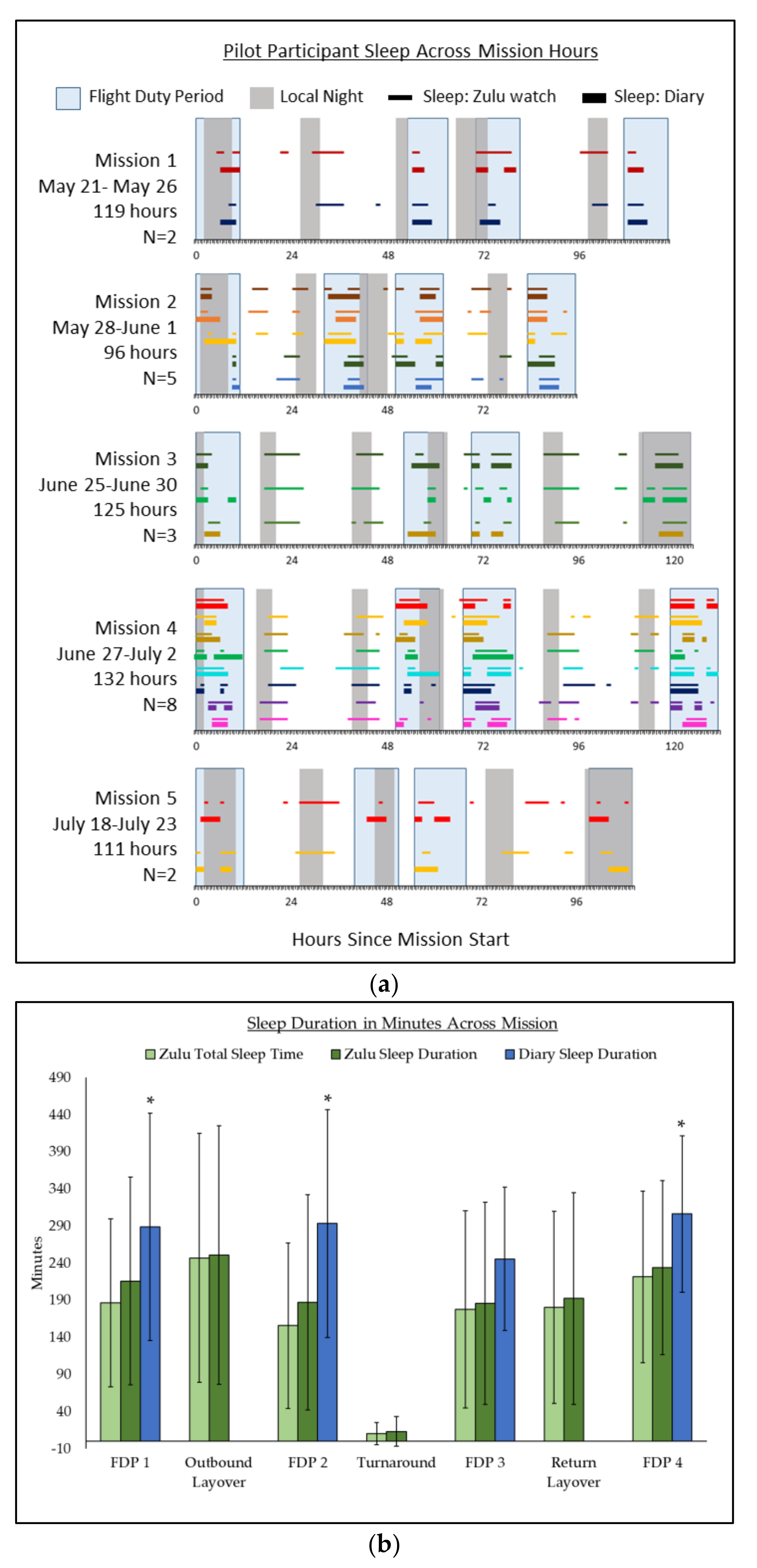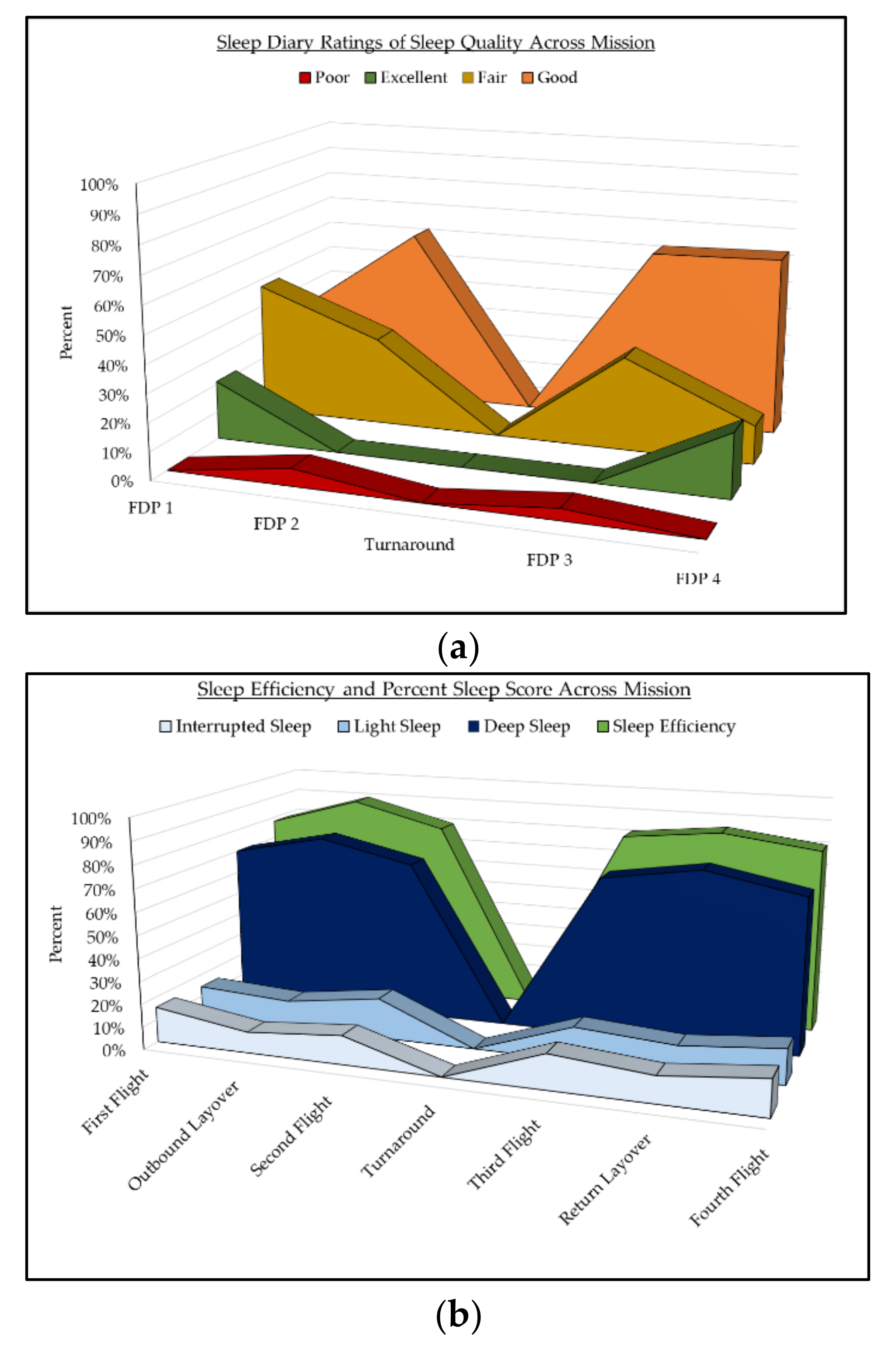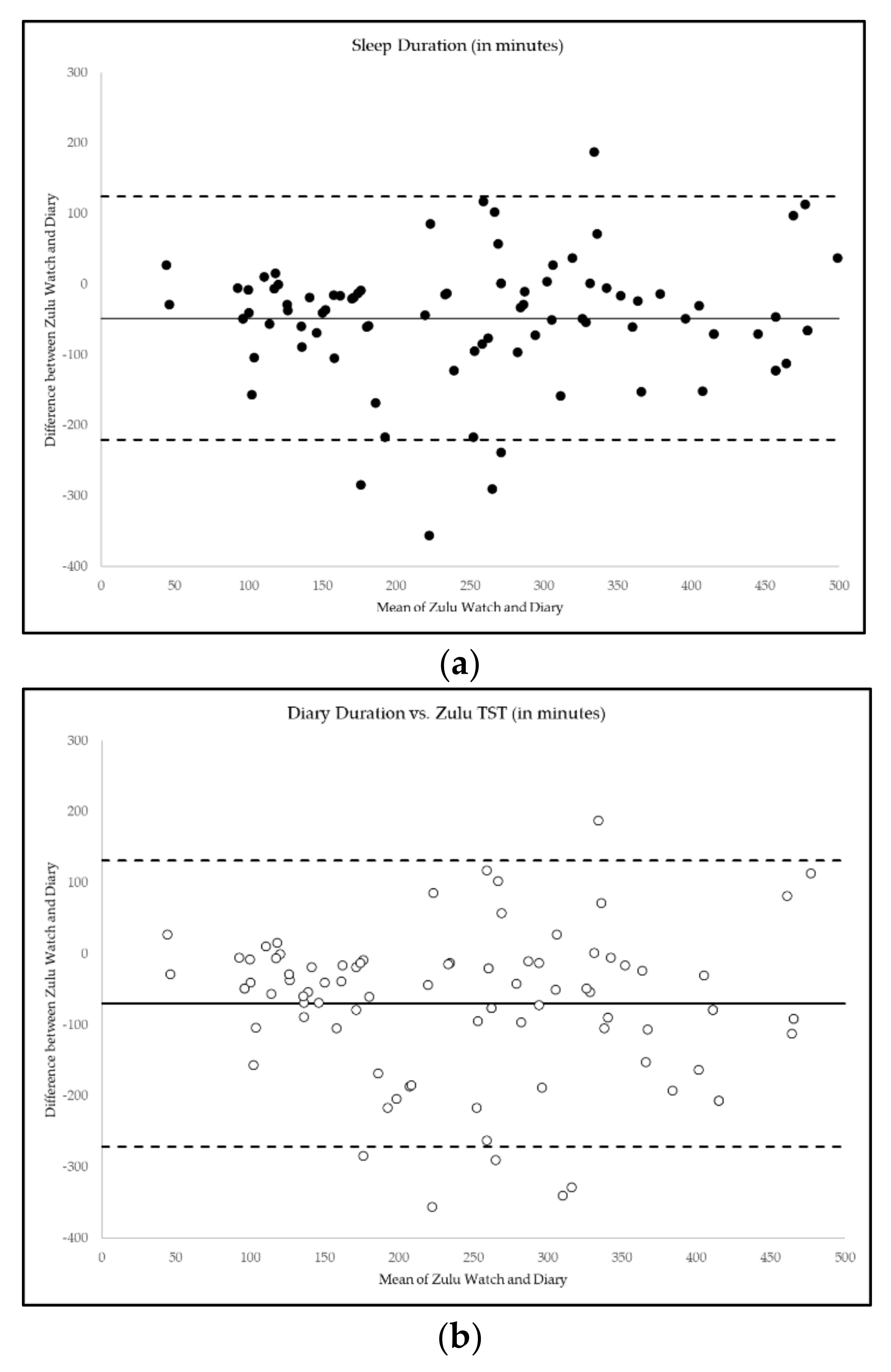Pilot Sleep Behavior across Time during Ultra-Long-Range Flights
Abstract
:1. Introduction
2. Results
2.1. Pilot Participation
2.2. Sleep Timing and Sleep Duration across Mission Hours
2.3. Sleep Quality and Sleep Score across Missions
2.4. Agreement between Zulu Watch and Diary Measurements of Sleep
3. Discussion
4. Materials and Methods
4.1. Participants
4.2. Procedures
4.3. Sleep Measures
4.3.1. Zulu Watch
4.3.2. Sleep Diary
4.4. Reformatting Data for Consistency between Zulu Watch and Diary Measurements
4.5. Data Analysis
5. Conclusions
Author Contributions
Funding
Institutional Review Board Statement
Informed Consent Statement
Data Availability Statement
Acknowledgments
Conflicts of Interest
References
- Gander, P.H.; Mulrine, H.M.; van den Berg, M.J.; Smith, A.A.; Signal, T.L.; Wu, L.J.; Belenky, G. Effects of sleep/wake history and circadian phase on proposed pilot fatigue safety performance indicators. J. Sleep Res. 2015, 24, 110–119. [Google Scholar] [CrossRef]
- Holmes, A.; Al-Bayat, S.; Hilditch, C.; Bourgeois-Bougrine, S. Sleep and sleepiness during an ultra long-range flight operation between the Middle East and United States. Accid. Anal. Prev. 2012, 45, 27–31. [Google Scholar] [CrossRef]
- Roach, G.D.; Darwent, D.; Dawson, D. How well do pilots sleep during long-haul flights? Ergonomics 2010, 53, 1072–1075. [Google Scholar] [CrossRef]
- Roach, G.D.; Darwent, D.; Sletten, T.L.; Dawson, D. Long-haul pilots use in-flight napping as a countermeasure to fatigue. Appl. Ergon. 2011, 42, 214–218. [Google Scholar] [CrossRef] [PubMed]
- Gander, P.H.; Signal, T.L.; van den Berg, M.J.; Mulrine, H.M.; Jay, S.M.; Jim Mangie, C. In-flight sleep, pilot fatigue and Psychomotor Vigilance Task performance on ultra-long range versus long range flights. J. Sleep. Res. 2013, 22, 697–706. [Google Scholar] [CrossRef]
- Hartzler, B.M. Fatigue on the flight deck: The consequences of sleep loss and the benefits of napping. Accid. Anal. Prev. 2014, 62, 309–318. [Google Scholar] [CrossRef] [PubMed]
- Gander, P.; Hartley, L.; Powell, D.; Cabon, P.; Hitchcock, E.; Mills, A.; Popkin, S. Fatigue risk management: Organizational factors at the regulatory and industry/company level. Accid. Anal. Prev. 2011, 43, 573–590. [Google Scholar] [CrossRef] [PubMed]
- Anund, A.; Fors, C.; Kecklund, G.; Leeuwen, W.v.; Åkerstedt, T. Countermeasures for Fatigue in Transportation: A Review of Existing Methods for Drivers on Road, Rail, Sea and in Aviation; Technical Report Number: VTI 852A; ResearchGate: Berlin, Germany, 2015. [Google Scholar]
- Bendak, S.; Rashid, H.S. Fatigue in aviation: A systematic review of the literature. Int. J. Ind. Ergon. 2020, 76, 102928. [Google Scholar] [CrossRef]
- Signal, T.L.; Gale, J.; Gander, P.H. Sleep measurement in flight crew: Comparing actigraphic and subjective estimates to polysomnography. Aviat. Space Environ. Med. 2005, 76, 1058–1063. [Google Scholar]
- Ferrara, M.; De Gennaro, L.; Casagrande, M.; Bertini, M. Selective slow-wave sleep deprivation and time-of-night effects on cognitive performance upon awakening. Psychophysiology 2000, 37, 440–446. [Google Scholar] [CrossRef] [PubMed]
- Neu, D.; Mairesse, O.; Newell, J.; Verbanck, P.; Peigneux, P.; Deliens, G. Does more sleep matter? Differential effects of NREM- and REM-dominant sleep on sleepiness and vigilance. Neurophysiol. Clin. 2015, 45, 167–175. [Google Scholar] [CrossRef]
- Arsintescu, L.; Kato, K.H.; Hilditch, C.J.; Gregory, K.B.; Flynn-Evans, E. Collecting Sleep, Circadian, Fatigue, and Performance Data in Complex Operational Environments. J. Vis. Exp. 2019. [Google Scholar] [CrossRef] [Green Version]
- De Zambotti, M.; Cellini, N.; Goldstone, A.; Colrain, I.M.; Baker, F.C. Wearable Sleep Technology in Clinical and Research Settings. Med. Sci. Sports Exerc. 2019, 51, 1538–1557. [Google Scholar] [CrossRef]
- Bhat, S.; Ferraris, A.; Gupta, D.; Mozafarian, M.; DeBari, V.A.; Gushway-Henry, N.; Gowda, S.P.; Polos, P.G.; Rubinstein, M.; Seidu, H.; et al. Is There a Clinical Role For Smartphone Sleep Apps? Comparison of Sleep Cycle Detection by a Smartphone Application to Polysomnography. J. Clin. Sleep Med. 2015, 11, 709–715. [Google Scholar] [CrossRef] [Green Version]
- Liang, Z.; Chapa-Martell, M.A. Accuracy of Fitbit Wristbands in Measuring Sleep Stage Transitions and the Effect of User-Specific Factors. JMIR Mhealth Uhealth 2019, 7, e13384. [Google Scholar] [CrossRef]
- Liang, Z.; Martell, M.A.C. Validity of consumer activity wristbands and wearable EEG for measuring overall sleep parameters and sleep structure in free-living conditions. J. Healthc, Informa. Res. 2018, 2, 152–178. [Google Scholar] [CrossRef]
- Asyali, M.H.; Berry, R.B.; Khoo, M.C.; Altinok, A. Determining a continuous marker for sleep depth. Comput. Biol. Med. 2007, 37, 1600–1609. [Google Scholar] [CrossRef] [PubMed]
- Younes, M.; Kuna, S.T.; Pack, A.I.; Walsh, J.K.; Kushida, C.A.; Staley, B.; Pien, G.W. Reliability of the American academy of sleep medicine rules for assessing sleep depth in clinical practice. J. Clin. Sleep Med. 2018, 14, 205–213. [Google Scholar] [CrossRef] [PubMed]
- Devine, J.; Garcia, C.R.; Simoes, A.S.; Guelere, M.R.; de Godoy, B.; Silva, D.S.; Pacheco, P.; Choynowski, J.J.; Hursh, S.R. Predictive Biomathematical Modeling Compared to Objective Sleep During COVID-19 Humanitarian Flights. Under submission.
- Devine, J.K.; Chinoy, E.D.; Markwald, R.R.; Schwartz, L.P.; Hursh, S.R. Validation of Zulu Watch against Polysomnography and Actigraphy for On-Wrist Sleep-Wake Determination and Sleep-Depth Estimation. Sensors 2020, 21, 76. [Google Scholar] [CrossRef] [PubMed]
- Muzet, A.; Werner, S.; Fuchs, G.; Roth, T.; Saoud, J.B.; Viola, A.U.; Schaffhauser, J.Y.; Luthringer, R. Assessing sleep architecture and continuity measures through the analysis of heart rate and wrist movement recordings in healthy subjects: Comparison with results based on polysomnography. Sleep Med. 2016, 21, 47–56. [Google Scholar] [CrossRef] [Green Version]
- Winnebeck, E.C.; Fischer, D.; Leise, T.; Roenneberg, T. Dynamics and Ultradian Structure of Human Sleep in Real Life. Curr. Biol. 2018, 28, 49–59. [Google Scholar] [CrossRef] [PubMed] [Green Version]
- Devine, J.K.; Choynowski, J.; Burke, T.; Carlsson, K.; Capaldi, V.F.; McKeon, A.B.; Sowden, W.J. Practice parameters for the use of actigraphy in the military operational context: The Walter Reed Army Institute of Research Operational Research Kit-Actigraphy (WORK-A). Mil. Med. Res. 2020, 7, 31. [Google Scholar] [CrossRef] [PubMed]
- Ancoli-Israel, S.; Martin, J.L.; Blackwell, T.; Buenaver, L.; Liu, L.; Meltzer, L.J.; Sadeh, A.; Spira, A.P.; Taylor, D.J. The SBSM Guide to Actigraphy Monitoring: Clinical and Research Applications. Behav. Sleep Med. 2015, 13 (Suppl. S1), S4–S38. [Google Scholar] [CrossRef] [PubMed]
- Paquet, J.; Kawinska, A.; Carrier, J. Wake detection capacity of actigraphy during sleep. Sleep 2007, 30, 1362–1369. [Google Scholar] [CrossRef] [PubMed]
- Marino, M.; Li, Y.; Rueschman, M.N.; Winkelman, J.W.; Ellenbogen, J.M.; Solet, J.M.; Dulin, H.; Berkman, L.F.; Buxton, O.M. Measuring sleep: Accuracy, sensitivity, and specificity of wrist actigraphy compared to polysomnography. Sleep 2013, 36, 1747–1755. [Google Scholar] [CrossRef] [PubMed]
- Short, M.A.; Gradisar, M.; Lack, L.C.; Wright, H.; Carskadon, M.A. The discrepancy between actigraphic and sleep diary measures of sleep in adolescents. Sleep Med. 2012, 13, 378–384. [Google Scholar] [CrossRef] [PubMed]
- Moore, C.M.; Schmiege, S.J.; Matthews, E.E. Actigraphy and sleep diary measurements in breast cancer survivors: Discrepancy in selected sleep parameters. Behav. Sleep Med. 2015, 13, 472–490. [Google Scholar] [CrossRef] [Green Version]
- Lauderdale, D.S.; Knutson, K.L.; Yan, L.L.; Rathouz, P.J.; Hulley, S.B.; Sidney, S.; Liu, K. Objectively measured sleep characteristics among early-middle-aged adults: The CARDIA study. Am. J. Epidemiol. 2006, 164, 5–16. [Google Scholar] [CrossRef] [PubMed] [Green Version]
- Depner, C.M.; Cheng, P.C.; Devine, J.K.; Khosla, S.; de Zambotti, M.; Robillard, R.; Vakulin, A.; Drummond, S.P.A. Wearable technologies for developing sleep and circadian biomarkers: A summary of workshop discussions. Sleep 2020, 43. [Google Scholar] [CrossRef] [Green Version]
- Aili, K.; Astrom-Paulsson, S.; Stoetzer, U.; Svartengren, M.; Hillert, L. Reliability of Actigraphy and Subjective Sleep Measurements in Adults: The Design of Sleep Assessments. J. Clin. Sleep Med. 2017, 13, 39–47. [Google Scholar] [CrossRef]
- Matthews, K.A.; Patel, S.R.; Pantesco, E.J.; Buysse, D.J.; Kamarck, T.W.; Lee, L.; Hall, M.H. Similarities and differences in estimates of sleep duration by polysomnography, actigraphy, diary, and self-reported habitual sleep in a community sample. Sleep Health 2018, 4, 96–103. [Google Scholar] [CrossRef] [PubMed]
- Devine, J.; Chinoy, E.; Markwald, R.; Devine, J.; Hursh, S. 260 Beyond Validation Testing: A Sleep Tracker for Longitudinal Data Collection in Operational Environments. Sleep 2021, 44, A104–A105. [Google Scholar] [CrossRef]
- Girschik, J.; Fritschi, L.; Heyworth, J.; Waters, F. Validation of self-reported sleep against actigraphy. J Epidemiol. 2012, 22, 462–468. [Google Scholar] [CrossRef] [PubMed]
- Bland, J.M.; Altman, D. Statistical methods for assessing agreement between two methods of clinical measurement. Lancet 1986, 327, 307–310. [Google Scholar] [CrossRef]




Publisher’s Note: MDPI stays neutral with regard to jurisdictional claims in published maps and institutional affiliations. |
© 2021 by the authors. Licensee MDPI, Basel, Switzerland. This article is an open access article distributed under the terms and conditions of the Creative Commons Attribution (CC BY) license (https://creativecommons.org/licenses/by/4.0/).
Share and Cite
Devine, J.K.; Choynowski, J.; Garcia, C.R.; Simoes, A.S.; Guelere, M.R.; Godoy, B.d.; Silva, D.S.; Pacheco, P.; Hursh, S.R. Pilot Sleep Behavior across Time during Ultra-Long-Range Flights. Clocks & Sleep 2021, 3, 515-527. https://doi.org/10.3390/clockssleep3040036
Devine JK, Choynowski J, Garcia CR, Simoes AS, Guelere MR, Godoy Bd, Silva DS, Pacheco P, Hursh SR. Pilot Sleep Behavior across Time during Ultra-Long-Range Flights. Clocks & Sleep. 2021; 3(4):515-527. https://doi.org/10.3390/clockssleep3040036
Chicago/Turabian StyleDevine, Jaime K., Jake Choynowski, Caio R. Garcia, Audrey S. Simoes, Marina R. Guelere, Bruno de Godoy, Diego S. Silva, Philipe Pacheco, and Steven R. Hursh. 2021. "Pilot Sleep Behavior across Time during Ultra-Long-Range Flights" Clocks & Sleep 3, no. 4: 515-527. https://doi.org/10.3390/clockssleep3040036
APA StyleDevine, J. K., Choynowski, J., Garcia, C. R., Simoes, A. S., Guelere, M. R., Godoy, B. d., Silva, D. S., Pacheco, P., & Hursh, S. R. (2021). Pilot Sleep Behavior across Time during Ultra-Long-Range Flights. Clocks & Sleep, 3(4), 515-527. https://doi.org/10.3390/clockssleep3040036




